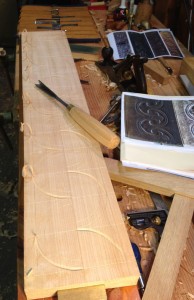Travelling Hexagon toolbox – Part 3
See Previous installments on this project here:
Today saw the completion of the third panel for my toolbox project, which I am pretty pleased with. This pattern is based on the work of Peter Follansbee whom I owe a great debt of gratitude to for his blog, and his heavy emphasis on authenticity and style.  He has done a great video on this exact pattern, which I believe is based on a pattern from a William Savell box from sometime in his life 1590 – 1669 which you can see here: http://pfollansbee.wordpress.com/2009/04/30/seventeenth-century-carved-boxes/
I took some liberties with the pattern, making it my own which was partially dictated by the tools I have and width and characteristics of the Alder. Â Based on all the images I’ve pored over, comparing patterns by the same maker, or from the same shop I think this is pretty much how the period craftsman did it.
This pattern is laid on a square grid due to the arcs that are the basis for this pattern. Â To find this scale, I laid out the long center-line, and the short center-line as usual, and used my dividers to find a spacing that worked which took a few tries to get right. Â I started with one point in the center and put the other near the top in what looked like a decent border for the edge. Â The first attempt was somewhere in the neighborhood of 1/2″, and when I walked this down the length to the end. Â The first attempt ended up roughly halfway to the end, so I adjusted the arm a little bit, and did it again until I found a measurement that looked right at the end and the top margin.
Pricking the top and bottom margin first, I used my marking gauge to set these in with the scratch point. Â Then I walked this out again along the center-line, pricking the board deep enough to leave a mark. Â Finally I used my square and awl to scratch a line at each of these points to complete the layout.
To create the arcs, I picked a point along the center and with my dividers scratched a half circle onto the top half. Â Leaving the point in the wood I scratched the bottom half, then repeat all the way down doing the top and bottom half. (Really, go by Follansbee’s video, he does a better job explaining this).
Then I pulled the arms in a little judging it by eye what would look good, and struck a series of arcs inside the first arc. Â This is my main outline for the circular bits which I followed the scratch lines with my V tool going down the line, stopping at the center line as seen above. (I snapped the picture showing the little pigtails that get left behind as I went down the line.)
Next it’s a simple matter to set in the fleur portion at the points where the half circles meet. I used small deep gouge first for the underside of the fleur, then followed by a bigger slightly less deep gouge to make the leaves. Â Remove the background with a small flat gouge, and bevel the outside of the top arc. Â Finish with the texture punch on the inside, and add come half moon gouge cuts to the top, followed by a nail punch accent just for kicks.
Here are the tools I used in this carving.
Three more panels to go!




Comments are Disabled